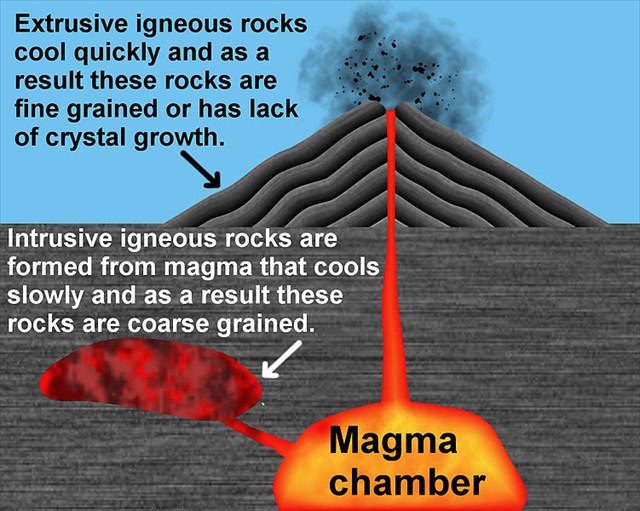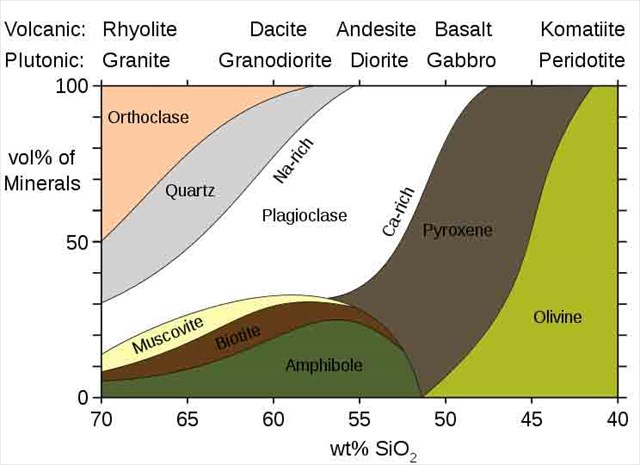The artwork has its form because the process of cooling lava can create hexagonal columns. NZ's oldest earthcache is about 15 kilometres due west of Taupo at Mason Rock, an example of such columns, and discusses this process so this earthcache is all about the ROCKS!
Over the past 26,500 years the Lake Taupo Caldera has erupted many times. There were two major eruptions - the Oruanui; the largest volcanic eruption in the world in the last million years, and the Taupo eruption in 186AD. The Taupo eruption propelled volcanic material 50km high into the air and produced violent pyroclastic flows.
There are 3 main types of rocks; igneous, sedimentary and metamorphic. Igneous rock (derived from the Latin word ignis meaning fire) is formed through the cooling and solidification of magma or lava. Igneous rock may form with or without crystallization, either below the surface as intrusive (plutonic) rocks or on the surface as extrusive (volcanic) rocks. All six of the rocks in the display are igneous volcanic rocks with mid to high silica content. They can be further classified by particle size which largely depends upon the cooling history.

Dacite is an igneous, volcanic rock of silica-intermediate composition. It has aphanitic (crystals too small to be seen) to porphytic (larger, clearly decernible crystals embedded in a finer-grained matrix) texture. The colour variants are due to the mineral composition. Feldspars, quartz, olivines, pyroxenes, amphiboles and micas are important minerals commonly found in all igneous rock.

Obsidian is a naturally occurring volcanic glass formed as an extrusive igneous rock.
It is produced when high silica (felsic) lava extruded from a volcano cools rapidly with minimum crystal growth. Obsidian is commonly found within the margins of lava flows where the felsic composition induces a high viscosity and polymerization degree of the lava. The inhibition of atomic diffusion through this highly viscous and polymerized lava explains the lack of crystal growth.
Obsidian is mineral-like, but not a true mineral because as a glass it is not crystalline; in addition, its composition is too complex to comprise a single mineral. It consists mainly of silicon dioxide (SiO2), usually 70% or more. Iron and magnesium typically give the obsidian its very dark colour.
Obsidian is hard and brittle; it therefore fractures with very sharp edges, which had been used in the past in cutting and piercing tools, and has been used experimentally as surgical blades.
Pumice is a volcanic rock that consists of highly vesicular (pitted with many cavities) rough textured volcanic glass, which may or may not contain crystals. It is typically light coloured. It has an average porosity of 90%, and initially floats on water.
Pumice is created when super-heated, highly pressurized rock is violently ejected from a volcano. The unusual foamy configuration of pumice happens because of simultaneous rapid cooling and rapid depressurization. The depressurization creates bubbles by lowering the solubility of gases (including water and carbon dioxide (CO2) that are dissolved in the lava, causing the gases to rapidly exsolve (like the bubbles of CO2 that appear when a carbonated drink is opened). The simultaneous cooling and depressurization freezes the bubbles in the matrix.
Pumice is in high demand particularly for water filtration, chemical spill containment, cement manufacturing, horticulture, cosmetic uses and increasingly for the pet industry.
Scoria is a highly vescular dark colored volcanic rock that may or may not contain crystals. It is typically dark in color (generally dark brown, black or purplish red), and has either more or less silica than dacite in composition. Scoria is relatively low in mass as a result of its numerous macroscopic ellipsoidal vesicles, but in contrast to pumice, all scoria has a specific gravity greater than 1, and sinks in water. The holes or vesicles form when gases that were dissolved in the magma come out of solution as it erupts, creating bubbles in the molten rock, some of which are frozen in place as the rock cools and solidifies. Scoria may form as part of a lava flow, typically near its surface, or as fragmental ejecta. The word scoria comes from the Greek word meaning rust. An old name for scoria is cinder.
To Log this Earthcache:
Please e-mail answers to the following questions to the CO through our profile page or if it is easier for you directly at jandalfan@gmail.com. Do not post the answers in your log but there is no need to wait for confirmation.
1. Compare the samples of the rocks at GZ. Based on their appearance including the surface condition, grain structure and colour which rock is in the shortest column?
2. Of the six rocks included in the display River Stones seem to be the odd one out. Their composition is not apparent from the name they are referred to. We know they are igneous rocks produced from the same volcano as the others so we could guess that they are water smoothed examples of one of the other rocks. Which rock is most likely to be the precursor of the River Stones and why?